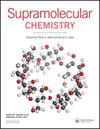Adamantane appended antimicrobial supramolecular self-associating amphiphiles
IF 2.6
4区 化学
Q3 CHEMISTRY, MULTIDISCIPLINARY
引用次数: 1
Abstract
ABSTRACT Herein, we present the synthesis of two novel adamantane appended supramolecular self-associating amphiphiles. The antimicrobial efficacy of these compounds is determined against both clinically relevant Gram-positive methicillin-resistant Staphylococcus aureus and Gram-negative Escherichia coli. We also explore the self-associative properties of these amphiphiles in both polar organic DMSO-d 6 0.5% H2O and H2O (D2O)/EtOH 19:1 solutions, confirming aggregate stability through the determination of zeta potential values, aggregate size through a combination of 1H NMR DOSY and dynamic light scattering studies as appropriate, and critical aggregate concentration through the derivation of concentration-dependent surface tension values. We also perform a variety of 1H NMR dilution studies and in-silico modelling to further explore the roles of intermolecular hydrogen bonding and lipophilicity within aggregate formation and antimicrobial efficacy. Finally, we perform haemolysis and Galleria mellonella toxicity assays to establish the potential of these compounds to undergo further development as antibiotic agents. Graphical Abstract金刚烷附加抗菌超分子自缔合两亲体
摘要本文合成了两种新型金刚烷自缔合超分子两亲体。这些化合物的抗菌功效是针对临床相关的革兰氏阳性耐甲氧西林金黄色葡萄球菌和革兰氏阴性大肠杆菌确定的。我们还探索了这些两亲化合物在极性有机DMSO-d 6 0.5% H2O和H2O (D2O)/EtOH 19:1溶液中的自结合性质,通过确定zeta电位值来确定聚集体的稳定性,通过适当的1H NMR DOSY和动态光散射研究相结合来确定聚集体的大小,并通过推导浓度依赖的表面张力值来确定临界聚集体浓度。我们还进行了各种1H NMR稀释研究和硅模拟,以进一步探索分子间氢键和亲脂性在聚集体形成和抗菌功效中的作用。最后,我们进行溶血和麦氏Galleria mellonella毒性试验,以确定这些化合物作为抗生素进一步开发的潜力。图形抽象
本文章由计算机程序翻译,如有差异,请以英文原文为准。
求助全文
约1分钟内获得全文
求助全文
来源期刊

Supramolecular Chemistry
化学-化学综合
CiteScore
3.60
自引率
3.00%
发文量
5
审稿时长
2.7 months
期刊介绍:
Supramolecular Chemistry welcomes manuscripts from the fields and sub-disciplines related to supramolecular chemistry and non-covalent interactions. From host-guest chemistry, self-assembly and systems chemistry, through materials chemistry and biochemical systems, we interpret supramolecular chemistry in the broadest possible sense. Interdisciplinary manuscripts are particularly encouraged. Manuscript types include: high priority communications; full papers; reviews, and; Methods papers, techniques tutorials highlighting procedures and technologies that are important to the field. We aim to publish papers in a timely fashion and as soon as a paper has been accepted and typeset it will be published in electronic form on the Latest articles section of the website. The two most important review criteria are that the paper presents high-quality work that fits generally into the broad spectrum of activities in the supramolecular chemistry field. Under normal circumstances, Supramolecular Chemistry does not consider manuscripts that would be more suitable in a highly specialized journal. This includes, but is not limited to, those based mostly or exclusively on topics such as solid state/X-ray structures, computational chemistry, or electrochemistry. .
The two most important review criteria are that the paper presents high-quality work that fits generally into the broad spectrum of activities in the supramolecular chemistry field.
 求助内容:
求助内容: 应助结果提醒方式:
应助结果提醒方式:


